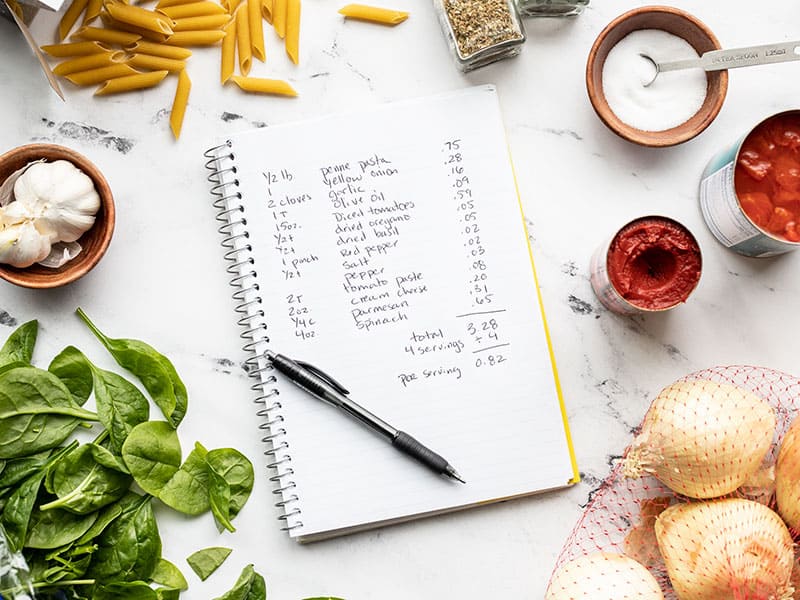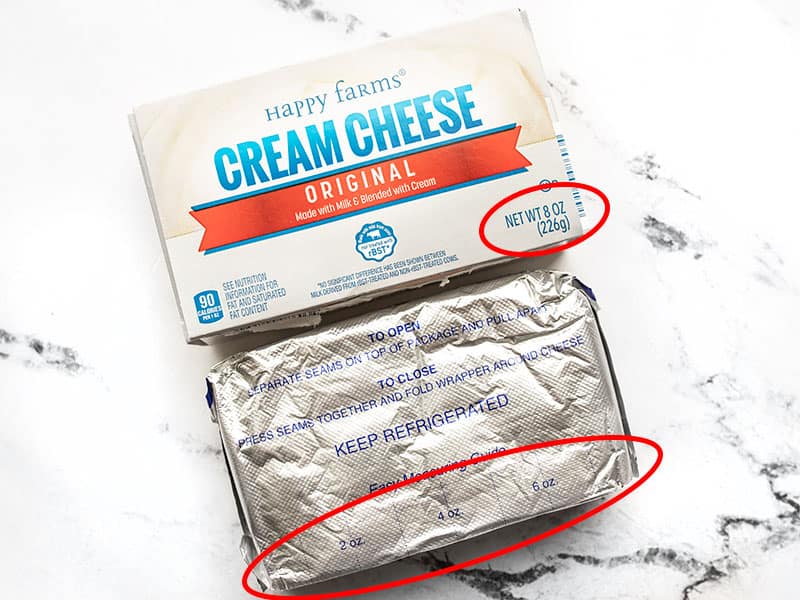The recipe cost breakdowns are a big part of Budget Bytes. And while you’re not likely to have the exact same food costs as me (prices vary quite a bit from location to location, day to day, and even store to store), I think it’s helpful to see how each ingredient can impact the overall cost of a recipe. So now I’d like to dive a little deeper to show you how I make these calculations, and teach you how to calculate recipe costs yourself. Because even if you do it once, I promise you’ll learn a lot!

Why Calculate Recipe Costs?
My big “Ah-ha!” moment came when I calculated the cost of my first few recipes. I was always very mindful of the total amount I spent at the grocery store every week, but seeing the breakdown of each ingredient and the total recipe cost that truly revolutionized my way of cooking.
Seeing this breakdown helped me learn how to tweak recipes to make them more filling for less money, while maintaining maximum flavor. I learned that scaling back just a little on the most expensive ingredients (nuts, cheese, meat, etc.) dramatically reduced recipe costs, but didn’t have a huge impact on flavor. Likewise, I learned which inexpensive ingredients helped give my food a big flavor kick for pennies (green onions, cilantro, freshly cracked pepper, dried herbs, etc.), and which ingredients I could use to bulk up a recipe without greatly increasing the total cost (rice, pasta, beans, lentils, cabbage, carrots, potatoes, etc.).
What Method Do You Use?
Here on Budget Bytes I use the same method of calculating recipe costs used by commercial food service operations—adding the costs of each ingredient used, in the amount used, rather than adding the full price of items purchased. Some argue that you can’t just buy 2 Tbsp of olive oil, so the recipe actually costs more to make. The counter argument to that is that you don’t buy an entire bottle of olive oil every time you make a recipe, nor do I consider an ingredient “free” if I already have it in my kitchen and didn’t need to buy it for that recipe. Both methods have their caveats, but I find the method used here to be the most representative of the recipe’s true cost.
What Do I Need to Calculate the Cost of a Recipe?
The process is simple and doesn’t require a lot of time or “equipment.” It’s so simple, in fact, that I do this, by hand, forevery single recipe on this website (well over 1000 recipe at this point). To calculate recipe costs you’ll need:
- Your receipts
- Original ingredient packages
- Pen and paper
- Calculator
- Grocery store website (as a backup for sourcing prices)
How To Calculate Recipe Costs – Step by Step Tutorial
Okay, so let’s walk through, step by step, what I do to calculate the cost of a recipe on Budget Bytes. For this tutorial, we’ll be using the Creamy Tomato and Spinach Pasta recipe as an example.
Step 1: Write down the recipe ingredients and quantities

If you like to print your recipes, you can do the calculations right on the printed version of the recipe. I always do my calculations in my recipe development notebook. You’ll fill out the prices in the right hand column as you do the calculations.
Step 2: Fill in prices for ingredients that were used “whole”.

Gather your receipts and record the prices for any ingredient that you used in the “whole” form. This could be ingredients like a can of tomatoes, a cucumber, maybe a jar of pasta sauce, a single bell pepper, etc. In this Creamy Tomato and Spinach Pasta there was only one ingredient that I used in the full volume purchased—diced tomatoes. You can see this item listed as “kro tomatoes $0.59” on the Kroger receipt. Record the price next to this item on your recipe ingredient list.
Note: If you don’t have your receipts, check your grocery store’s website. Some larger stores, like Kroger, allow you to look up items online and the price will be displayed.
Step 3: Calculate Bulk Produce Items

For bulk produce items, take the total price listed on the receipt and divide by the number of items purchase. The total price for this bag of yellow onions listed on the receipt was $1.69 and there are six onions in the bag, so each onion is approximately $0.28. Record this price on your recipe ingredient list.
This method works good for other bagged produce, like apples, carrots, oranges, lemons, potatoes, etc. and also things like packages of chicken thighs or breasts.

For garlic, each head is usually around $0.60-$0.65 and I get on average about 8 good sized cloves from each head, so I just estimate about $0.08 per clove.
Step 4: Use Package Labels to Calculate Partial Ingredient Costs
For most ingredients you’ll need to use the information listed on the ingredient packages to determine the cost of the amount used in the recipe. Here are some examples:

This recipe used 1/2 lb. of penne pasta. The whole box (1 lb.) cost $1.49. Since I used half the box, the cost of the amount used is $1.49 ÷ 2 = $0.75.

The same method was used for this bag of spinach. The full 8 oz. bag cost $1.29, so the cost of the 4 oz. used is $1.29 ÷ 2 = $0.65.
Sometimes the manufacturers are nice and provide helpful guides for measuring. This full 8 oz. package of cream cheese cost $0.79, so the cost of the 2 oz. used in the recipe is $0.79 ÷ 4 = $0.20.

Sometimes the calculations can get a little more involved. The cost of this 6 oz. can of tomato paste was $0.39. We can see on the nutrition label that there are 5 servings of 2 Tbsp in the can, or a total of 10 Tbsp per can. We used 2 Tbsp for the recipe, so the cost of what we used is $0.39 ÷ 5 = $0.08.

I bought this bottle of olive oil a while back, so I had to refer to Kroger.com to get the price. The total price for this bottle was $5.95. We can see on the nutrition label that there are 66 servings of 1 Tbsp in the whole bottle. We used 1 Tbsp for the recipe, so the cost of what we used is $5.95 ÷ 66 = $0.09.

This Parmesan cheese is about as complicated as the calculations usually get because we’re converting between unit types. We see on the label that there are 45 servings of 2 tsp in the whole bottle. We used 1/4 cup in the recipe. So first I calculated the cost per tsp: $2.29 (total bottle price) ÷ 45 ÷ 2 = $0.025 per tsp. I know there are 3 tsp per tablespoon, and 4 tablespoons per 1/4 cup, so I calculated a little further: $0.025 x 3 x 4 = $0.31 per ¼ cup.
Step 5: Estimate Costs for Herbs and Spices

Herbs and spices don’t have nutrition labels with serving sizes to work with, and often the entire container only weighs less than 2 oz. Unfortunately I don’t have a kitchen scale that is sensitive enough to weigh something as light as a 1/2 tsp of a dry herb. So, for my purposes I use a generic (and generous) allotment of $0.10 per tsp for most dried herbs and spices. For salt and pepper I estimate a little less and for any rare herbs or spices I double the generic estimation. So, for this recipe: 1/2 tsp dried basil = $0.05, 1/2 tsp dried oregano = $0.05, 1 pinch crushed red pepper = $0.02, 1/2 tsp salt = $0.02, freshly cracked pepper = $0.03
Step 4: Add it all together!
So finally, we have all of the prices of the ingredients filled in on the recipe ingredient list. Now just simply add them all together and then divide by the number of servings and you’ve got the price per serving. So for this recipe, the total cost was $3.28 and with four servings that’s $3.28 ÷ 4 = $0.82 per serving.

As you can see, it’s not an exact science, but it will definitely shed some light on where your money is really going. I hope you try it out at least once just to see how it goes. If you want to do it on a regular basis, you can start a spreadsheet with price per unit information for your pantry staples. This way you’ll have a record of the price for items that you may only buy a few times per year (and probably won’t have the receipt handy). Luckily, my blog acts as a “record” of these prices, so I can quickly refer back to my last purchase price.
What About Electricity, Gas, and Water?
Every now and then I get a question about how utilities add to my recipe costs. Unfortunately I don’t have a way to measure the amount and cost of the most of the utilities used in the recipes, but I’m confident that it would be a very small amount. For instance, in this recipe I used 1/2 cup water in the sauce. After checking my last water bill, I paid $0.003 per gallon of water. I round to the nearest cent for these calculations, so the cost of the 1/2 cup water in this recipe is negligible. Water is easy to measure, but I don’t think I could measure the amount of gas or electricity used to heat the oven.
Handy Conversions for Calculating:
- 3 tsp = 1 Tbsp
- 4 Tbsp = 1/4 cup
- 2 Tbsp = 1 fluid ounce
- 16 Tbsp = 1 cup
- 2 fluid ounces = 1/4 cup
- 8 fluid ounces = 1 cup
- 16 weight ounces = 1 pound
NOTE: “fluid ounces” are a volume unit, weight ounces are a measurement of mass. Solid ingredients are usually listed as weight ounces, liquid ingredients are usually listed in fluid ounces. 8 fluid ounces of one ingredient may not equal 8 weight ounces of that same ingredient. That will depend on the individual density of the ingredient. Cheese is a great example. 4 oz. (weight) of cheese is equal to about one cup (volume) of shredded cheese. One cup is 8 fluid ounces in volume, but only 4 weight ounces of shredded cheese.
Try It Yourself!
I hope I didn’t scare you off with all these calculations! It really is quite simple, especially after you do it a few times. If you’re interested in giving it a shot, start with a simple recipe that only has 3-5 ingredients and see how you do! Then, let me know how it worked out in the comments below. :)
P.S. Did you know you can browse our recipes by Cost per Recipe and Cost per Serving?
